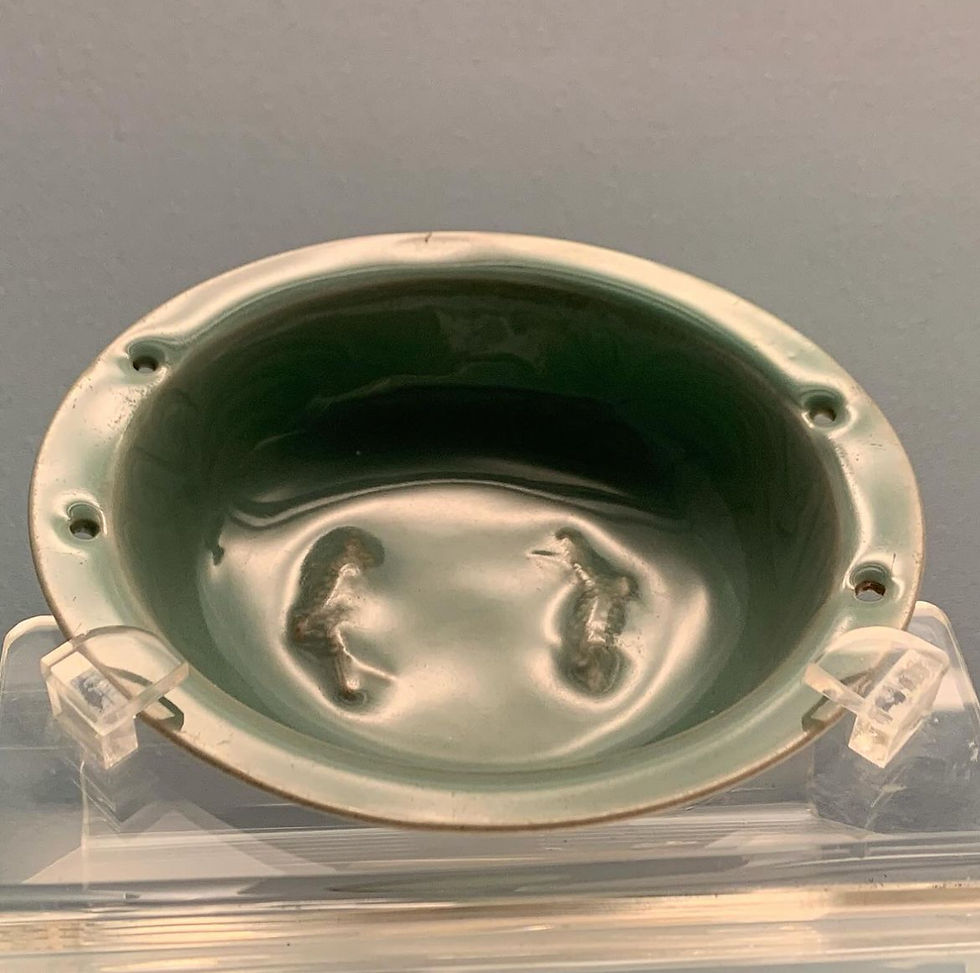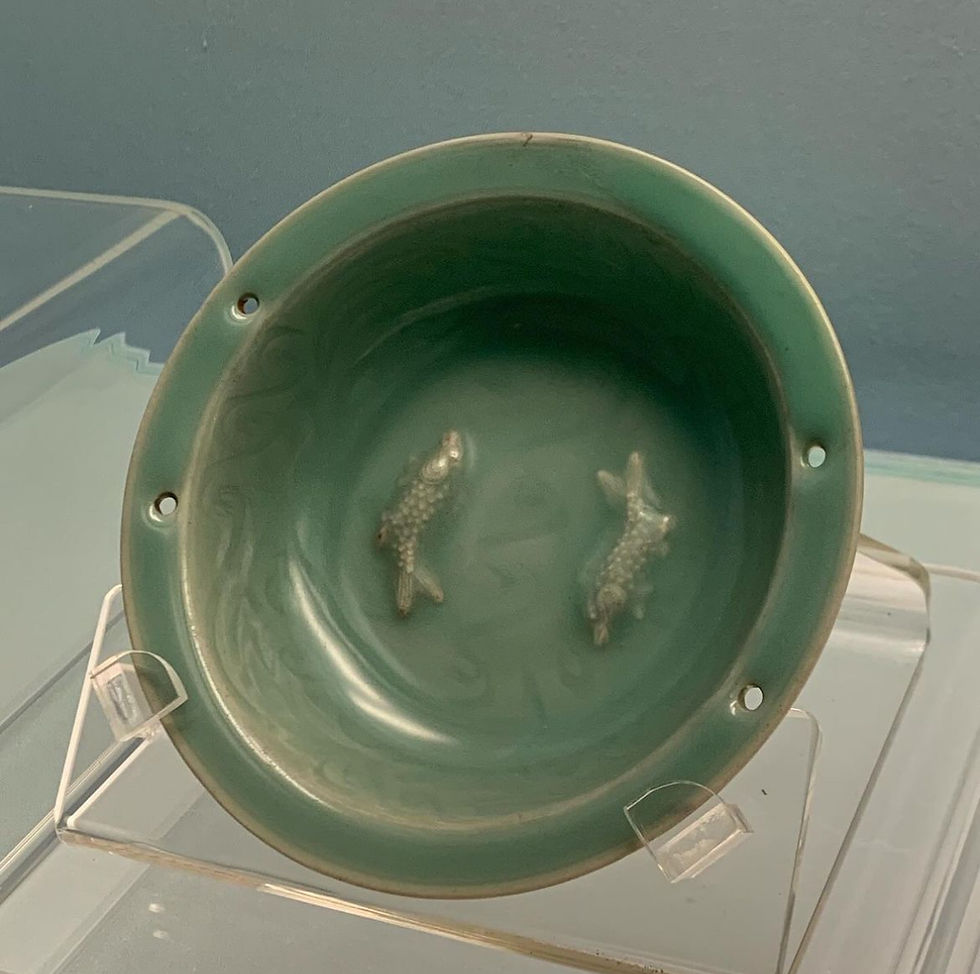宋代筆記vol.03 上海博物館:南宋至元代龍泉窯四孔劃花雙魚洗 - Shanghai Musuem, Southern Song to Yuan Dynasty Longquan Twin Fish Basin
- SACA
- Feb 10, 2024
- 5 min read
Updated: Feb 25

元代龍泉窯四孔劃花雙魚洗
南宋 — 元時代,上海博物館藏
狀態:口沿似有小補釉。四孔雙魚洗存世量極少,台北故宮存有一例,尺寸大約在22cm以上。這類南宋晚期,元代早期的雙魚洗在當時十分受歡迎。
這件雙魚洗是典型的梅子青釉,實際上,頂級的梅子青比粉青釉要更為罕見。四孔雙魚洗是雙魚洗中的聖杯,大維德基金會藏有兩件,其中一件為著名東方陶瓷學會藏家克拉克的舊藏。
這類藏品的特色主要看:1. 魚的大小及肥美程度(通常為鱖魚);2. 尺寸大小(大的更為難得);盆洗比折沿洗更少;釉色的瑩潤程度。
雙魚洗問答
什麼是「四孔雙魚洗」,它的產製時間是何時?
四孔雙魚洗是一種長泉窯出品的陶瓷盆洗,應該出自南宋晚期至元代早期。其特徵是在洗內刻有兩條魚,最具特色的是洗的底部或側面鑿有四個小孔。
為什麼四孔雙魚洗如此珍貴?
四孔雙魚洗的價值主要來自其極為罕見,現存例子極少。除此之外,精湛的工藝、釉色(尤其是梅子青釉)、盆洗的尺寸大小,以及形狀(盆洗相比折沿洗更為稀少)等因素,均大大提高了其價值。其來源,例如曾經由知名收藏家擁有,也會顯著提升其價值。
評估這些雙魚洗的關鍵特徵有哪些?
主要特徵包括:刻魚的大小和豐滿程度(通常為鱖魚),洗的整體尺寸(較大者更為罕見且更具價值),形狀(盆洗比折沿洗更少見),以及釉色的光澤度和平滑度。
什麼是「梅子青」釉,為什麼它如此重要?
梅子青釉(梅子青)是一種特定的青瓷釉色,呈現深邃的綠色,猶如熟透的梅子。就長泉青瓷而言,梅子青釉被認為比粉青釉更加罕見,通常也更具價值,這反映了其製作過程中的高超技藝和品質。
四孔雙魚洗的例子可以在哪些地方找到?
此類雙魚洗的實物可見於多個重要藏品中,包括上海博物館、台北故宮博物院以及大維德基金會等。
為什麼這些雙魚洗如此受收藏家青睞?
這些雙魚洗代表了長泉青瓷的巔峰之作,其稀有性使其備受追捧。精湛的工藝、卓越的釉色、極具美學的外觀以及深厚的歷史意義,使其成為收藏家心目中的珍品。
盆洗的大小對其價值有何影響?
較大的雙魚洗比小型的更為罕見,因此被認為更具價值。原因在於大型作品更難在燒製過程中保持完好無缺,且需要更多的資源和技術才能成功製作。
修復痕跡對價值有重大影響嗎?
儘管陶瓷的狀況在定價中是一個因素,但小範圍的釉面修補,特別是在口沿處,對古董陶瓷來說並不罕見。四孔雙魚洗的稀有性和整體品質可能會使它在某些情況下,即使有輕微缺損,仍具相對高價值。然而,若出現較為明顯的損毀,則無疑會對其價值造成影響。

Yuan Dynasty Longquan Kiln Four-Hole Carved Double Fish Basin
Southern Song to Yuan Period, Collection of the Shanghai Museum
Condition: The rim appears to have small glaze repairs. The Four-Hole Double Fish Basin is extremely rare, with one example housed in the National Palace Museum in Taipei, measuring over 22 cm. Double fish basins from the late Southern Song to early Yuan period were highly popular during their time.
This basin exemplifies the typical plum-green glaze, which is rarer than the powder-green glaze. The Four-Hole Double Fish Basin is considered the pinnacle among this type, with two examples held in the Great Wei De Foundation's collection, one of which was previously owned by the renowned collector of the Oriental Ceramic Society, Clark.
The key characteristics of such pieces include:
The size and plumpness of the fish (typically representing the mandarin fish);
The size of the basin (larger examples are even more rare);
The shape, with basin forms being rarer than those with folded edges;
The smoothness and luster of the glaze.

FAQ Longquan Twin Fish Basin
What is a "Four-Hole Double Fish Basin" and when was it produced?
A Four-Hole Double Fish Basin is a type of ceramic basin produced at the Longquan kilns, likely from the late Southern Song Dynasty to the early Yuan Dynasty. It features two carved fish inside the basin and, most distinctively, four small holes around the basin's base or side.
Why are Four-Hole Double Fish Basins considered so valuable?
Their value stems from their extreme rarity. Very few examples are known to exist. Further adding to their value are the quality of the craftsmanship, the color of the glaze (particularly plum-green), the size of the basin, and the shape (basins being rarer than those with folded edges). Provenance, such as previous ownership by renowned collectors, also significantly increases their value.
What are the defining characteristics used to evaluate these basins?
Key characteristics include: the size and plumpness of the carved fish (often representing mandarin fish), the overall size of the basin (larger examples are rarer and more desirable), the shape of the basin (basins are rarer than those with folded rims), and the quality, smoothness, and luster of the glaze.
What is "plum-green" glaze, and why is it significant?
Plum-green (梅子青) is a specific type of celadon glaze characterized by its deep, rich green color, reminiscent of the color of ripe plums. In the context of Longquan celadon, plum-green glaze is considered rarer and often more desirable than powder-green glaze (粉青), reflecting a higher level of skill and quality in its production.
Where can examples of Four-Hole Double Fish Basins be found?
Examples are held in prominent collections, including the Shanghai Museum, the National Palace Museum in Taipei, and the Great Wei De Foundation.
Why are these basins considered desirable among collectors?
These basins represent the pinnacle of Longquan celadon ware, and their scarcity makes them highly coveted. The combination of skilled craftsmanship, superior glaze, aesthetic appeal, and historical significance contributes to their desirability.
How does the size of the basin influence its value?
Larger basins are rarer than smaller ones and therefore considered more valuable. This is because larger pieces are more difficult to fire without imperfections, and they require greater resources and skill to produce successfully.
Is the presence of repairs a major detriment to value?
While condition is a factor in valuation, small glaze repairs, particularly to the rim, are not uncommon in antique ceramics. The rarity and overall quality of a Four-Hole Double Fish Basin can outweigh minor imperfections in some cases. However, more significant damage would undoubtedly affect its value.
















Comments